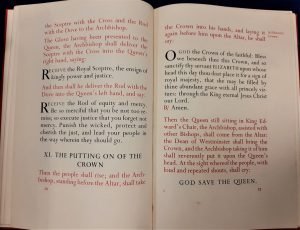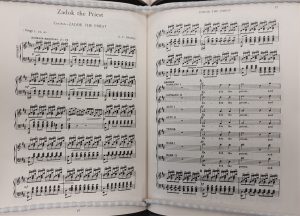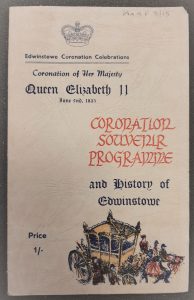June 2, 2022, by Kathryn Steenson
The Queen’s Platinum Jubilee
On 2nd June 1953, Princess Elizabeth of York was crowned Queen Elizabeth II. She had ascended the throne on 6 February the previous year, when her father George VI died after a long period of ill-health. She was 25 when crowned; now, at the age of 96, she has reigned for 70 years and is both the longest-reigning English monarch and the longest-reigning female monarch in the world.
The coronation ceremony was held at the Collegiate Church of Saint Peter at Westminster, more widely known as Westminster Abbey. Every English/British monarch has been crowned there since William the Conqueror in 1066. It was the first coronation ceremony to be televised and was watched by an estimated 277 million people worldwide. Here’s a selection of archive documents produced for the occasion, 70 years ago.
Tickets to the Coronation of Queen Elizabeth II, 2 June 1953
Irene Lorriman was born on 13 April 1915. She was employed by John Player and Sons Ltd, cigarette manufacturer, of Nottingham in the late 1930s. She joined the civilian division of the War Ministry in 1941 and was appointed to the War Office as a clerical officer with the status of a civil servant in 1948. At about this time, she was recommended for an MBE. She and a guest were invited to the War Office to watch the Coronation procession from the windows, but were not amongst the 7000 guests in the Abbey itself. Tickets were colour-coded: blue here indicates the bearer was allocated to the Haymarket area. The procession included not just the Queen in the royal carriage, but thousands of armed services personnel. The route from Buckingham Palace to the Abbey was around 5 miles long and lined with thousands of spectators.
The Form and Order of Service for the Coronation of Her Majesty Queen Elizabeth II, 2 June 1953
Ref: Ma 9 F/6/3-4
We have multiple copies of the Order of Service for the Coronation, depending on the owner’s role in the ceremony. These two copies are part of the collection of the Earls Manvers. Earl and Countess Manvers probably attended the Coronation of Queen Elizabeth II as a Peer and Peeress.
All attendees were expected to be in their places in Westminster Abbey before the doors closed at 8.30am, 20minutes before the arrival of the Royal procession. The red-bound Order of Service was also only given to invited guests seated in the Abbey. It contains much less detail about the movements (printed in black) and instead includes the spoken parts of the service (in red), so that the audience can follow along and respond at the appropriate moment.
This copy of the Ceremonials to be observed at the coronation was given to invited guests and contains layouts indicating where everyone involved in the ceremony was sitting or standing. There are also detailed breakdowns of the complicated actions to be carried out when: who is carrying the various swords, jewels, and Bibles; when the Queen’s regalia is either put on or removed and by whom; which hand should be clasped or kissed during the Oaths. It is clearly intended to be read by those with an active part in the ceremony.
Form, Order of Service and Music for the Coronation of Queen Elizabeth II, 2 June 1953
The ceremony was divided into four parts: (1) the entrance of the Queen, the Recognition, Oath and presentation of the Bible; (2) Holy Communion; (3) the Anointing, Investiture, Coronation and Enthroning of the Queen; and (4) the thanksgiving.
This Order of Service is the only one we have which contains the score for the music in the Coronation, here open at Zadok the Priest. Composed by George Frideric Handel for the coronation of King George II in 1727, it has been sung prior to the anointing of the sovereign at the coronation of every British monarch since its composition. The anointing is exactly what it sounds like: the Queen kneels as the Archbishop leads the prayers and then, as Zadok the Priest is sung, four Knights of the Garter hold a canopy of gold cloth over the Queen and the Archbishop anoints the Queen with holy oil in the sign of the cross.
Coronation Souvenir Programme and History of Edwinstowe, for the Edwinstowe Celebrations for the Coronation of Her Majesty Queen Elizabeth II, listing events to take place from 28 May to 2 June 1953
Coronation celebrations were not limited to the day itself. This programme shows the Queen’s schedule of official visits around the country in June and July.
Sadly she did not call in at Edwinstowe for the two days of celebrations held there. These included teas and concerts for children and old people, a fancy-dress parade, a children’s dog show, performances by the Thoresby Colliery band, and culminated in a bonfire and fireworks.
The original records featured here are held in Manuscripts & Special Collections. To find out more about our collections or to book an appointment to visit the Reading Room, please contact us mss-library@nottingham.ac.uk.
No comments yet, fill out a comment to be the first







Leave a Reply